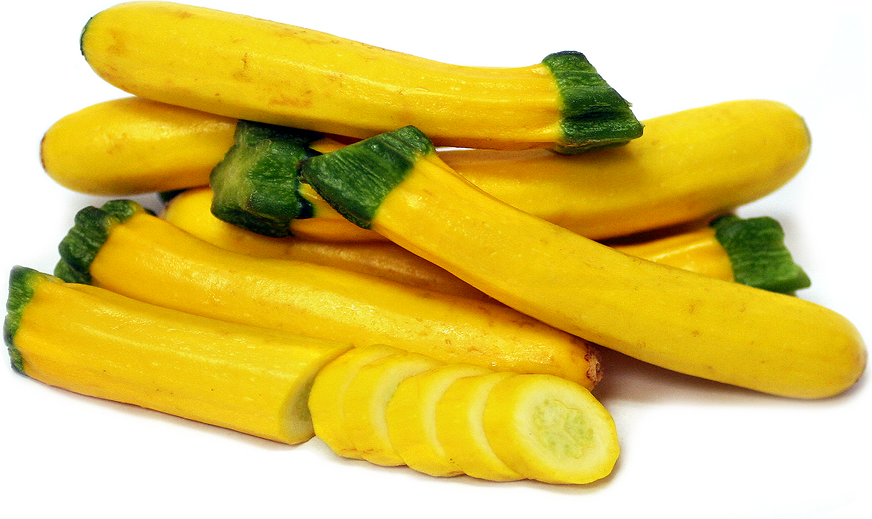


Baby Gold Bar Squash
Estimated Inventory, 10 lbs : 0
Description/Taste
Baby Gold Bar squash is a small, cylinder-shaped vegetable. Measuring 10 to 15 centimeters in length, this bright yellow squash has smooth, waxy skin with a dark green stem at its blossom end. The flesh of Baby Gold Bar squash is light yellow with a soft tender flesh and barely visible seed cavity. These small seeds are flat and oval-shaped with a creamy white hue. Baby Gold Bar squash has a subtly sweet fragrance with vegetal undertones characteristic of most squash varieties. Its flavor is mild yet smooth, blending sweetness with a nutty essence.
Seasons/Availability
Baby Gold Bar squash is available year-round, though it peaks late summer through fall.
Current Facts
The botanical name for Baby Gold Bar squash is Cucurbita pepo, the same as all other squashes, gourds, and pumpkins. It belongs to the Cucurbitaceae family. Baby Gold Bar squash is a miniature version of the larger Gold Bar squash. This summer squash achieves its small size because it's harvested at an immature stage and thus doesn’t develop hard seeds or tough skin. Other popular varieties of summer squash include Crookneck, Pattypan, Bossa Nova, Costata Romanesco, Partenon, Sunburst, Tromboncino, and Zephyr. These varieties develop on bushy plants with sturdy stems and large, lobed leaves. Summer squash comes in many shades including green, white, two-toned, and yellow. Because they are cultivated for tenderness, their skin does not require peeling, and their miniature size makes them perfect for smaller gardens.
Nutritional Value
The nutritional value of Baby Gold Bar squash does not vary much from its more mature counterpart, though it may contain a smaller amount of nutrients. Yellow squash has vitamins A and C, nutrients responsible for maintaining healthy vision and skin, immune function, bone growth, oral health, and helping reduce the risk of chronic diseases like heart disease. Squash has fiber that may help with digestion, lowering cholesterol levels, and controlling blood sugar. It also contains, phosphorus, magnesium, and folate, which help with muscle and nerve health, brain function, processing carbohydrates and fats, regulating blood pressure, and maintaining healthy cell and tissue development. The majority of the nutrients in Baby Gold Bar squash are in its skin.
Applications
Baby Gold Bar squash can be eaten raw, sautéed, grilled, roasted, or fried. Fresh Baby Gold Bar squash can be shredded and tossed on top of a salad or spiralized for a healthy alternative to pasta. It can be roasted with olive oil, sliced and skewered on kebabs, used in a chilled Gazpacho soup, tossed into a quinoa salad, added to a stir-fry, or hollowed out and stuffed with breadcrumbs, herbs, and cheese. Baby Gold Bar squash is versatile in sweet dishes, easily grated into breakfast muffins, sweet breads, or bundt cakes. It can be pureed and used to thicken sauces and soups or made into baby food. The mild flavor of Baby Gold Bar squash pairs well with ingredients like parmesan, feta, goat cheese, almonds, pine nuts, cherry tomatoes, bell peppers, onions, eggplant, corn, garlic, sausage, and poultry. It is complemented by herbs and spices like basil, thyme, rosemary, paprika, cumin, and garlic powder. The delicate skin of Baby Gold Bar squash makes it harder to store and more susceptible to bruising. Ideally, it should be used soon after harvest or stored in a refrigerator to be used within a week.
Ethnic/Cultural Info
Gold squash is believed to have originated in the 1990s. Its development began when seeds from a leading hybrid produced a squash displaying 50% of the desired yellow color. Throughout many seasons of selection and fermentation, the golden yellow hue was finally achieved and the Gold squash was born. The term “squash” comes from the Native American word "askoot asquash”, which means eaten raw. The names squash and pumpkin are often used interchangeably in botanical classification. This can sometimes be seen as arbitrary in some contexts because what is called a pumpkin in one country may be called a squash in another. What this indicates is how terminologies using vegetables like these have evolved over centuries and been influenced by many different languages and cultures. It has been domesticated over the past 10,000 years to build up chemical defenses and enhance specific traits like size, flavor, shape, and color.
Geography/History
Baby Gold Bar squash is a descendant of the Cucurbita genus, which is native to Mesoamerica. They thrive in warm climates with full sun exposure and most soils. Because they are harvested prematurely, Baby Gold Bar squash are not found in the wild and are instead grown on commercial farms or in home gardens. The vegetable species that Baby Gold Bar squash is a descendant of dates back 10,000 years, having been found in Oaxaca, Mexico, in the Guila Naquitz cave. Squash made its way to the Old World via Columbus and would undergo much of its development and hybridization in Italy. Later, these hybridized varieties were carried to the Americas through immigrants in the 1920s. As they are not as common as their regular-sized counterparts, Baby Gold Bar squash is most likely to be found at farmers markets, specialty stores, or in home gardens.
Recipe Ideas
Recipes that include Baby Gold Bar Squash. One
| Martha Stewart |
|
Shaved Raw Summer Squash with Parmesan Dressing |
| Chocolate and Zucchini |
|
Yellow Zucchini Tarte Fine on a Yogurt-Based Crust |
| Creative Culinary |
|
Lemony Summer Squash Bread |


















